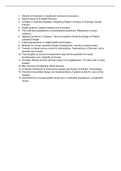1. Notions of innovation in healthcare services and products
2. Special Issue on E-Health Services
3. e-Health in Vascular Diseases: Integrating Digital Innovation in Everyday Clinical
Practice
4. Health systems, systems thinking and innovation
5. The multi-level perspective on sustainability transitions: Responses to seven
criticisms
6. Aligning Concerns in Telecare: Three Concepts to Guide the Design of Patient-
Centred E-Health
7. Critical perspectives on digital health technologies.
8. Methods for human-centered eHealth development: narrative scoping review.
9. Towards a shared service centre for telemedicine: Telemedicine in Denmark, and a
possible way forward
10. Technologies for inclusive employment: beyond the prosthetic fix–social
transformation axis. Disability & Society.
11. A healthy lifestyle and the adverse impact of its digitalization: The dark side of using
eHealth
12. Why We Use and Abandon Smart Devices
13. A Holistic Framework to Improve the Uptake and Impact of eHealth Technologies
14. Persistent inequitable design and implementation of patient portals for users at the
margins.
15. Interventions to increase patient portal use in vulnerable populations: a systematic
review.
,Notions of innovation in healthcare services and products
Author: Page, T. et al., 2014.
Abstract: This investigation explores the role innovations play in the healthcare
system within the UK. Discussions include the debate surrounding the definition of the
term innovation, as well as the importance of innovations on patients and the current
barriers that halt innovations being implemented. The study concludes by suggesting
that the term ‘innovation’ is overused and therefore it is unsurprising that many people
become confused, suggestions are made for more detailed definitions and possibly
clearer definitions within specific industries. Other conclusions include recommendations on
the way innovations are approached by the healthcare industry as well as the believed
barriers to innovations.
Key points:
● The dictionary definition of innovation is ‘Something new or different
introduced’.
● Difficult to define innovation.
● The term innovation is both overused and too broad.
● Innovation may only be called an innovation if it has positive or worthwhile outcomes.
● Main barriers for innovation: funding, people’s reluctance to change, time, difficult to
get agreement, don’t know the correct process, academics not having enough
timetabled time to engage in enterprise, policy, publicity, encouragement, and
awards.
● School systems can promote creativity and innovative thinking (current UK system
does not do that)
The first category, class one, covers products that patients use and interact with,
products such as walking sticks and crutches. At the other end of the scale, class three
includes products that are invasive, products such as needles and pacemakers.
● Class one: Even though it’s relatively easy to design, develop and implement
these innovations, the impact they have is limited and the overall benefit they deliver
to the patient isn’t as great as a pacemaker for example.
● Class three: Though it was discussed that it’s notoriously difficult to design and
develop a product for this class, it also has to be considered that these
innovations provide a massive impact on patients’ lives, which can ultimately have
the potential to save lives
Conclusions:
● For a product or service to be classed as an innovation within the NHS, it has to aid
the patient or help the healthcare professional in the process.
● Either way the cost of implementing an innovation into this sector (healthcare)
would cost more compared to a similar product in a different sector. This is
because of the stringent tests and processes an innovation has to go through.
● From this investigation it has been established that innovations in healthcare
provide real value to the NHS, these innovations play a major part in driving the trust
forward, and provide better care for the patients.
, ● The main barriers that are highlighted from all stages of research were the
lack of both time and funding, more specifically the lack of timetabled
enterprise time for academics and healthcare professionals, as well as the lack of
funding from large companies, though grants and sponsorships are becoming a more
popular avenue for funding.
● The investigation suggests that the best way to innovate is from getting people
together with different skill sets and devising questions that need to be answered.
● The answer to the title, Is the use of innovative design important during patient
rehabilitation? Would also most certainly be yes.




